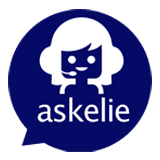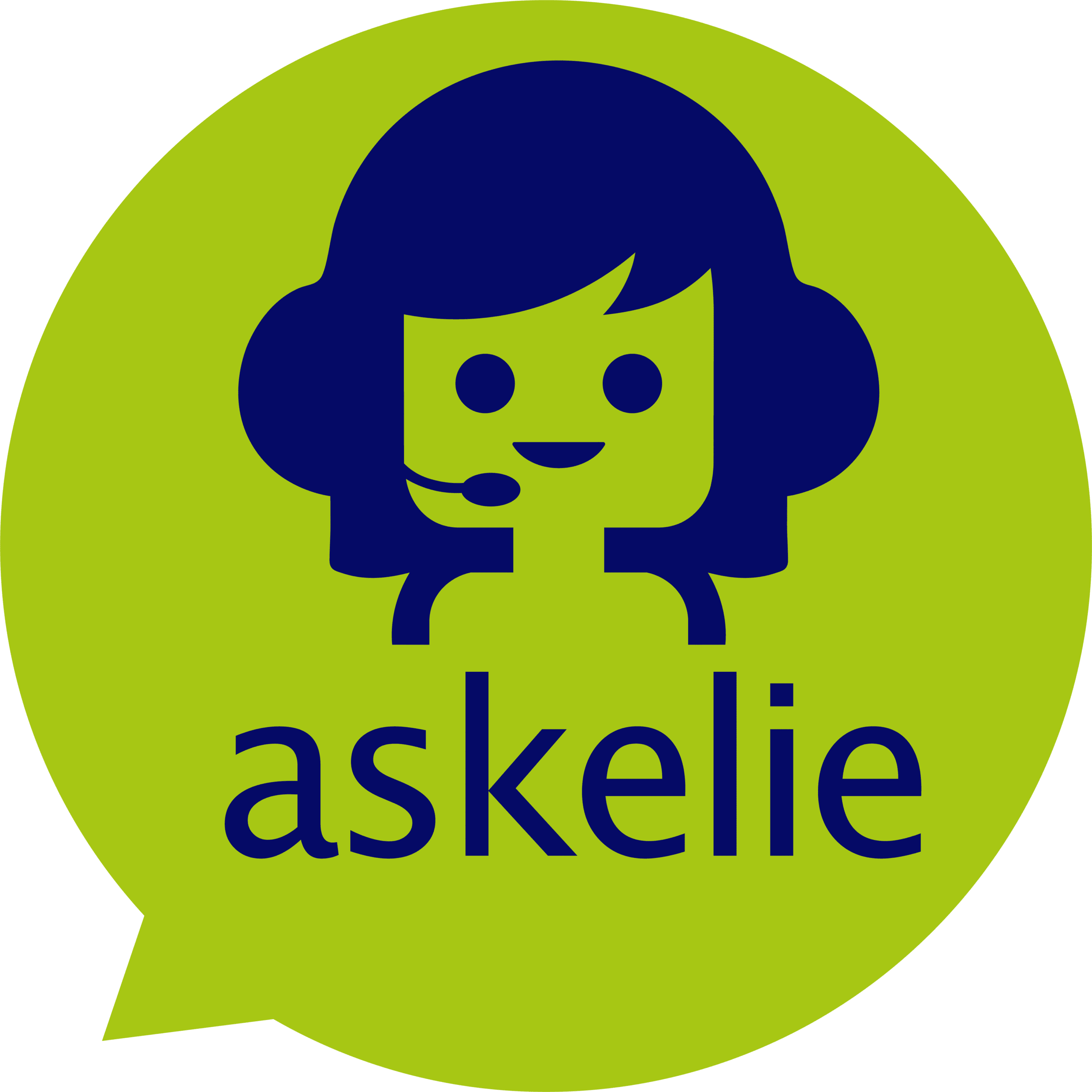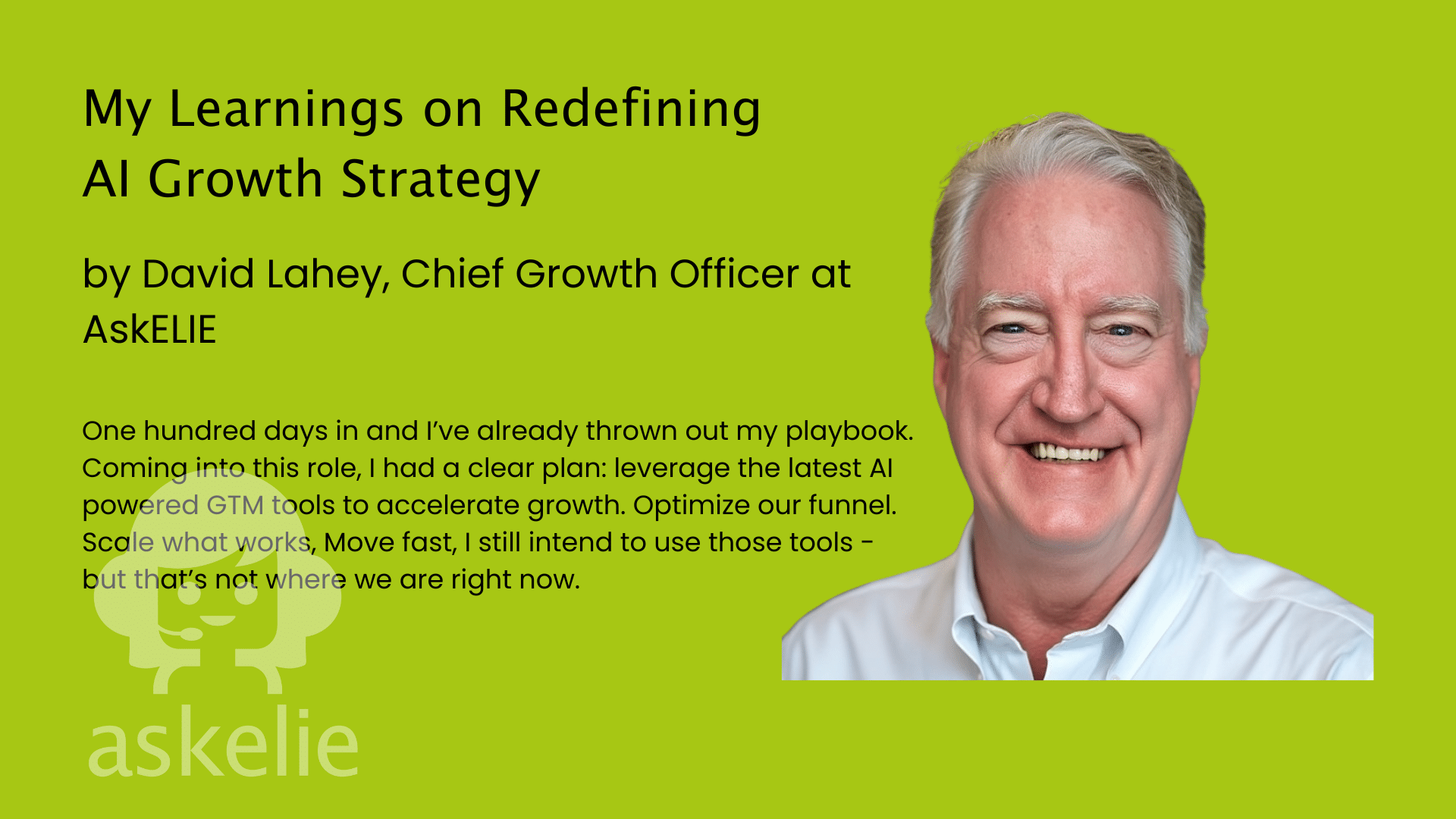AI growth strategy is being redefined across the industry, and at AskELIE, it’s happening from the inside out. One hundred days in and I’ve already thrown out my playbook.
Coming into this role, I had a clear plan: leverage the latest AI-powered GTM tools to accelerate our growth. Optimize our funnel. Scale what works. Move fast. I still intend to use those tools—but that’s not where we are right now.
What I discovered in my first 100 days is that speed is the wrong objective. Right now, it’s about listening, understanding, and aligning. I know that true wisdom is found in the act of inquiring and seeking understanding. Our AI growth strategy focuses on long-term trust over hype.
After joining AskELIE, I was most surprised by the depth of digital workers already created across verticals. Legal, HR, Education, Accessibility, Contract Intelligence—workers that touch every organization in virtually every vertical market. This isn’t a product looking for a market. It’s a platform that’s already working in markets most companies are still trying to figure out.
That realization changed everything. Because if AI is evolving this fast, and if the hype cycle is still this loud, then rushing to “growth hack” our way forward might actually be the riskiest move we could make.
3 Paradigms for a Modern AI Growth Strategy
So instead, I’ve focused on three paradigms that feel counterintuitive for a growth leader—but essential for an AI-native company trying to build something real. A strong AI growth strategy begins with data.
1. Data before hype: Build the foundation that cuts through the noise
The AI industry is drowning in hype. Every vendor promises transformation. Every pitch deck shows hockey-stick projections. But when you talk to enterprise buyers, they’re asking one question: “Show me what actually works.”
My first priority in these 100 days was standing up our internal CRM to truly understand our customers. Not for typical sales tracking, but to capture the real stories behind AI adoption—the wins, the challenges, the specific use cases that move the needle.
Why does this matter for growth? Because in a market saturated with AI promises, the scarcest resource isn’t attention, it’s trust. Enterprises aren’t buying features anymore. They’re buying proof. They need real case studies, concrete use cases, and domain-specific insights to architect their own AI strategies.
This isn’t about collecting testimonials. It’s about building an intelligence system that helps us understand what actually drives value for our customers, so we can help prospects architect their own success before they even become customers. When everyone else is selling hype, we’re selling real outcomes.
2. Identity over integration: Why proprietary models create competitive moats
Early in my tenure, we crystallized our messaging around a critical question: “Why AskELIE and not just ChatGPT?”
This question gets to the heart of what it means to be an AI-native company versus a company that’s added AI. We’re not a traditional software platform with ChatGPT bolted on. We built AskELIE from the ground up as a modern hyperautomation platform: combining RPA, ML, low-code development, and workflow orchestration to deliver vertical digital workers that complete multiple tasks, not just chatbots that generate text or agents that focus on a single task.
The growth insight? Proprietary models that understand your domain create a defensible market position. AskELIE’s AI growth strategy balances innovation and alignment. A generic LLM can write an email. Our platform can understand the nuances of procurement workflows, compliance requirements, and industry-specific processes because we’ve built models that learn from doing the work. It also continually learns, which is where our name comes from: Ever Learning Intelligent Engine.
From a growth perspective, this distinction is everything. Generic AI is a race to the bottom—it’s commoditized, price-driven, and easily replicated. Domain-specific AI that gets smarter with every deployment is a partnership that compounds in value over time.
Don’t just plug and play with AI, because the market will plug and play with you.
3. Network as strategy: Growth through partnership, not just pipeline
Our customers aren’t just customers—they are truly our partners in our go-to-market strategy.
Here’s what I mean: Our customers are the subject matter experts in their domains. They know the workflows, the pain points, and the business outcomes that matter. We deliver a state-of-the-art platform. Together, we create solutions that neither of us could build alone.
This has fundamentally changed how I approach growth. My network isn’t a pipeline to be mined. It’s a village helping grow this company. I’ve spent significant time having real conversations about the status of AI adoption at enterprises, understanding their challenges, and striving to build win-win strategies together.
The old growth playbook was transactional: generate leads, nurture them, close deals, move on. The new playbook is relational: engage deeply, learn continuously, co-create value, and build something bigger together.
Much like raising a child, growth in the AI era requires loving involvement, consistency, effective communication, leading by example, patience, and fostering independence. And just like the proverb says, “It takes a village to raise a child.” We’re not building this company in isolation. We’ll be successful through the teamwork of our internal staff and the support of our network.
Beyond the first 100 days: What comes next
If these first 100 days taught me anything, it’s that building an AI-native growth function requires patience with a plan.
The bold experiment I’m most excited about? Transforming our CRM from a system of record into a system of action. I want to challenge the traditional SDR to AE to CSM motion and test whether a self-optimizing GTM loop can outperform manual pipeline management. Can the system itself recognize when a customer or prospect is ready for the next conversation? Can it surface the right use case at the right time? Can it learn from every interaction and get better without us having to retrain it?
That’s the promise of being AI-native—not just using AI tools, but building systems that improve themselves.
And if we’re going to measure that, we need better metrics. Most companies measure AI by proxy: model accuracy, cost savings, time reduction. Those are inputs, not outcomes. What I’m tracking is something I call Rate of Autonomous Value Creation (RAVC)—the percentage of business outcomes that are initiated, executed, and closed without direct human intervention. Revenue generated. Insights surfaced. Customer actions taken. Product improvements shipped. All without someone manually pulling the levers.
For an AI-native company, that’s the metric that matters. Not how much AI we have, but how much value it creates on its own.
I come into this new role after having been a Chief Customer Officer as well as a VP of Sales. When I combine that with my love of live music, I’m reminded that really good live music doesn’t happen by accident. Neither does revenue growth or an excellent customer experience. Both require practice, expertise, timing, and the ability to read the room and adapt in real time. You can have the best musicians in the world, but if they’re not listening to each other, it falls apart. You can have the best AI platform in the world, but if it’s not aligned with what customers actually need, it’s just noise.
These first 100 days have been about tuning the instruments and remembering to listen. The next 100 will be about playing the music: together with our team, our customers, and the village that’s helping us build this.
What can other business leaders learn from AskELIE’s AI growth strategy? In an AI market still thick with hype, the companies that win won’t necessarily be the ones that move fastest—they’ll be the ones that listen deepest. Build the foundation for your AI growth strategy on customer intelligence, not marketing automation. Invest in proprietary understanding of your domain, not generic tool integrations. And recognize that your network isn’t a pipeline to extract value from, but a village to build value with. Speed will matter eventually. But right now, in this moment of AI transformation, understanding matters more.



Brian
18 October 2025 01:20Perhaps the best thing you've ever written, Dave. Smart insights, looking for the right outcomes. When you do it, your customers will be raving fans and your best proof. Until, at least, the AI just finds those new customers itself, for you. Well said. Go get 'em.